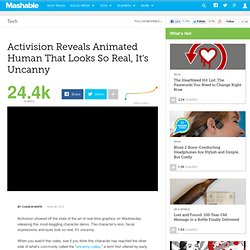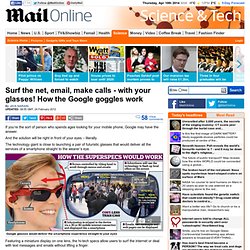

Activision Shows Off Animated Human That Looks So Real, It's Uncanny. Activision showed off the state of the art of real-time graphics on Wednesday, releasing this mind-boggling character demo.

The character's skin, facial expressions and eyes look so real, it's uncanny. When you watch this video, see if you think this character has reached the other side of what's commonly called the "uncanny valley," a term first uttered by early robotics guru Masahiro Mori in 1970. It describes the range of sophistication of animated graphics, from one side of the valley where human figures simply look unrealistic, to the middle of the valley — where they look just realistic enough to be creepy — to our side of the valley, where animation is indistinguishable from reality. Whenever the uncanny valley is mentioned, the animation techniques from the November, 2004 movie Polar Express come to mind.
Most viewers noticed the characters weren't quite photorealistic enough to keep them out of the creepy zone. I think this is impressive, but not perfect yet. Nanomedicine Art Gallery - Exhibit List. Magnetic levitation. Magnetic levitation, maglev, or magnetic suspension is a method by which an object is suspended with no support other than magnetic fields.

Magnetic pressure is used to counteract the effects of the gravitational and any other accelerations. Earnshaw's theorem proves that using only ferromagnetic or paramagnetic materials it is impossible to stably levitate against gravity; however, servomechanisms, the use of diamagnetic materials, superconduction, or systems involving eddy currents allow to achieve that. In some cases the lifting force is provided by magnetic levitation, but there is a mechanical support bearing little load that provides stability. This is termed pseudo-levitation. Magnetic levitation is used for maglev trains, magnetic bearings and for product display purposes. Lift[edit] where Stability[edit] Static[edit] Cool Websites, Software and Internet Tips.
Ipad-Iphone. iPhone Firmware Downloads. Mobile-Tech. Google glasses: Surf the net, email, make calls - how the Google goggles work. By Jaya Narain Updated: 08:55 GMT, 24 February 2012 If you’re the sort of person who spends ages looking for your mobile phone, Google may have the answer.

And the solution will be right in front of your eyes – literally. The technology giant is close to launching a pair of futuristic glasses that would deliver all the services of a smartphone straight to the wearer’s eye. Google glasses would deliver the smartphone experience straight to your eyes Featuring a miniature display on one lens, the hi-tech specs allow users to surf the internet or deal with text messages and emails without lifting a finger. The screen is controlled with a ‘mouse’ which is moved simply by tilting your head.
Reports suggest the device, which would revolutionise the smartphone market, could be available by the end of this year costing less than £380 – making it cheaper than Apple’s iPhone. It has been reported the glasses will resemble Oakley's Thump sunglasses Google declined to comment. Holograms On iPad Demoed On Video Using Sixth Sense Technology. I’ve heard many people taking about technology as a whole and that it’s not advancing as fast as in recent years which will eventually lead to a stagnation.

I don’t agree at all with this statement and I believe that the advancement in technology will blow the mind of those who disagree. Per example, take a look at a technology called Sixth Sense developed by a MIT research assistant called Pranav Mistry. During the TED conference a couple of years ago, Pranav demoed a portable projector which gives people the possibility to interact with objects and the information displayed by the objects. When Sixth Sense will be adopted at large scale will allow people to see the reviews of a book in real time then holding the book. The Sixth Sense projector knows that book your are holding and it will search the internet for reviews of that book.
Pattie Maes and Pranav Mistry demo SixthSense. Open-source fabrication technologies. Signal Boosters. Scientists engineer nanoscale vaults to encapsulate 'nanodisks' for drug delivery. There's no question, drugs work in treating disease.

But can they work better, and safer? In recent years, researchers have grappled with the challenge of administering therapeutics in a way that boosts their effectiveness by targeting specific cells in the body while minimizing their potential damage to healthy tissue. The development of new methods that use engineered nanomaterials to transport drugs and release them directly into cells holds great potential in this area. And while several such drug-delivery systems — including some that use dendrimers, liposomes or polyethylene glycol — have won approval for clinical use, they have been hampered by size limitations and ineffectiveness in accurately targeting tissues.
Now, researchers at UCLA have developed a new and potentially far more effective means of targeted drug delivery using nanotechnology. The UCLA research team was led by Leonard H. "Vaults can have a broad nanosystems application as malleable nanocapsules," Rome added. GADGETS-PHONES. Emkwan. Sell and Recycle Used Electronics - Gazelle.
ROBOTICS. Emerging Technologies.